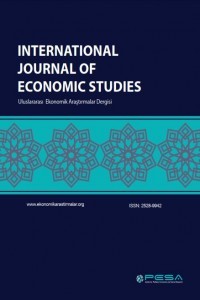The Determinants of Female Labor Force Participation for OECD Countries
The Determinants of Female Labor Force Participation for OECD Countries
Female labor force participation rate for women aged between 25 and 54 has increased from 54 percent in 1980 to 61 percent in 2013 in OECD countries. The reasons for this increase could be investigated by looking at the factors affecting labor demand and supply. Labor demand is mainly determined by the increase in production, the development of part-time and public sector employment. Whereas the factors affecting labor supply are considered as the increase in female educational attainment, postponement of fertility and the change in the attitude of female employment. Also economic, cultural and sociological issues are the factors affecting female labor force participation in the OECD countries. The aim of this paper is to analyze the determinants of female labor force participation in OECD countries which are per capita GDP, unemployment rate, ratio of female to male tertiary enrollment, fertility rate and the number of waged and salaried workers using panel logit model. The data is obtained from World Bank database and covers the period between 1990 and 2013. It is found that unemployment rate, gross domestic product per capita and fertility rate are affecting the female labor force participation rate positively and significantly. Fertility rate is found to be the variable with the highest effect on female labor force participation rate
Keywords:
Female labor force participation rate, panel logit model OECD countries, unemployment rate, fertility rate,
___
- Asteriou, Dimitrios and Hall Stephen (2007), Applied Econometrics a Modern Approach using Eviews and Microfit, Palgrave Macmillan, New York.
- Baltagi, Badi (2008), Econometric Analysis of PanelDdata, John Wiley & Sons, Ltd.,UK.
- Berber, Metin and Eser Burçin Yılmaz (2008), “Türkiye’de Kadın İstihdamı: Ülke ve Bölge Düzeyinde Sektörel Analiz, İş Güç Endüstri İlişkileri ve İnsan Kaynakları Dergisi”, Sayı: 10, Cilt: 2, pp. 2-16.
- Blau, Francine and Kahn Lawrence (2013), Female Labor Supply: Why is the US falling Behind?, National Bureau of Economic Research Working Paper, Number :18702.
- Davidson, Russell and Mackinnon James (1999), Econometric Theory and Methods, Oxford University Press, New York.
- Dvorkin, Maximiliano and Shell Hannah (2015), A Cross Country Comparison of Labor Force Participation, Economic Synopses, Federal Reserve Bank of St. Louis, No.17.
- Heij, Christian De Boer Paul, Franses, Philip Hans Kloek, Teun and Dijk, Herman (2004), Econometric Methods with Applications in Business and Economics, New York: Oxford University Press.
- Jaumotte, Florence (2003), Female Labour Force Participation: Past Trends and Main Determinants in OECD Countries, OECD Economics Department Working Papers, No.376, OECD Publishing.
- Kennedy, Peter (2006), Ekonometri Kılavuzu (Çev. M. Sarımeşeli ve Ş. Açıkgöz), Gazi Kitabevi, Ankara.
- Kızılgöl, Özlem Ayvaz (2012),”Kadınların İşgücüne Katılımının Belirleyicileri: Ekonometrik Bir Analiz”, Doğuş Üniversitesi Dergisi, Sayı: 13, Cilt: 1, pp. 88-101.
- Kinoshita, Yuko and Guo Fang (2015), What can Boost Labor Force Participation in Asia?, IMF Working Paper, Number: 56.
- Korkmaz, Ademand and Korkut Gülsüm (2012), “Türkiye’de Kadının İşgücüne Katılımının Belirleyicileri”, Süleyman Demirel Üniversitesi İktisadi ve İdari Bilimler Fakültesi Dergisi, Sayı: 17, Cilt: 2, pp.41-65.
- Küçükkalay, A. Mesud (1998), “Türkiye'de Planli Dönemde Kadin Nüfusu ve Kadin İşgücü İstihdamindaki Gelişmeler”, Süleyman Demirel Üniversitesi İktisadi ve İdari Bilimler Fakültesi Dergisi, Sayı:3, Cilt:3, pp.35-44.
- Linacre, Susan (2007), “Labour Force Participation – an International Comparison”, Australian Social Trends, Number: 4102.0, pp. 1-7.
- Mishra, Vinod and Smyth Russell (2010), “Female Labor Force Participation and Total Fertility Rates in the OECD: New Evidence from Panel Cointegration and Granger Causality Testing”, Journal of Economics and Business, Number:2, pp. 48-64.
- Özer, Mustafa and Biçerli Kemal (2003), “Türkiye’de Kadın İşgücünün Panel Veri Analizi”, Anadolu Üniversitesi Sosyal Bilimler Dergisi, Sayı: 3, Cilt: 1, pp. 55-86.
- Özerkek , Yasemin (2014), “Türkiye’de Ücretli İstihdam ve Büyüme (1988-2013)”, Marmara Üniversitesi İ.İ.B.F Dergisi ,Cilt: 36, Sayı:1, pp. 215-227
- Özsoy, Ceyda and Sevilay Atlama (2010), An Analysis of Trends in Female Labor Force Participation in Turkey, Challenges for Analysis of the Economy, the Business and Social Progress, Reviewed Article.
- Pampel, Fred (2000), Logistic Regression a Primer, London: International Educational and Professional Publisher Series/Number 07/132, Sage Publications, 2.
- Pazarlıoğlu, Vedat and Gürler Özlem Kiren (2007), “Telekomünikasyon Yatırımları ve Ekonomik Büyüme: Panel Veri Yaklaşımı”, Finans Politik ve Ekonomik Yorumlar, Sayı: 44, Cilt: 508, pp.35-43.
- Siah, Audrey and Lee Grace (2014), “Female Labour Force Participation, Infant Mortality and Fertility in Malaysia”, Monash Business School, Department of Economics, ISSN 1441-5429, Discussion Paper Number: 54-14, pp. 1-25.
- Tansel, Aysit (2002), Economic Development and Female Labor Force Participation in Turkey: Time Series Evidence and Cross-Province Estimates, Economic research Center, ERC Working Papers in Economics, Number: 01/05.
- Thevenon , Olivier (2013), Drivers of Female Labor Force Participation in the OECD, OECD Social, Employment and Migration Working Papers, Number: 145.
- Timurçin, Deniz (2010), Türkiye’de KOBİ’lerin Rekabet Gücü ve Rekabet Üstünlüğü Sağlamada Kümelenmenin Etkisi, Yayımlanmamış Doktora Tezi, İstanbul Üniversitesi Sosyal Bilimler Enstitüsü, İstanbul, pp. 221-222.
- Yenilmez, Füsun and Bayraç Işıklı (2010), “The Comparison of Labor Force Participation Rate of Women in Turkey with the World Country Groups”, Anadolu Üniversitesi Sosyal Bilimler Dergisi, Number:10, Volume: 3, pp. 77-92.
- Wooldridge, Jeffrey (2003), Introductory Econometrics: A Modern Approach. U.S.A: South-Western College Publishing.
- World Bank Report (2009), Female Labor Force Participation in Turkey: Trends, Determinants, and Policy Framework, T.R. Prime Ministry, State Planning Organization Report No 48508-TR.
- ISSN: 2528-9942
- Başlangıç: 2015
- Yayıncı: Politik Ekonomik ve Sosyal Araştırmalar Merkezi
Sayıdaki Diğer Makaleler
Meltem İrteş GÜLŞEN, Şennur ÖZTÜRK
Gülsüm Gürler HAZMAN, Mustafa KÜÇÜKİLHAN
Türk İmalat Sanayinde Sektörler Bazında Verimlilik Çıktı İlişkisi: Verdoorn Yasası
Türkiye'de Gelişmişlik Düzeyi Farklılıklarının Analizi
İşın ÇETİN, Mustafa SEVÜKTEKİN
Minsky Haklı mıydı: 2008 Küresel Ekonomik Krizi Bağlamında Bir Analiz
Muhammed Veysel KAYA, Hasan Önder SARIDOĞAN
The Determinants of Female Labor Force Participation for OECD Countries
